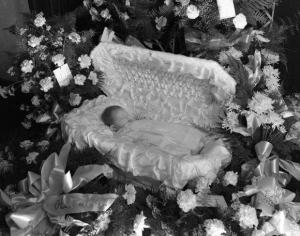Post-mortem photography
Posted: October 30, 2012 Filed under: Photographic Archives, Photographs | Tags: death, post-mortem photography, rites 1 CommentHalloween and All Souls’ Day seem like a good time to talk about corpses and death rites. People all over the world honor their dead around this time of the year – tending the graves of loved ones, and preparing special foods and decorations.
Post-mortem photography is another tradition centered on the dead. While it might seem morbid according to today’s sensibility, the practice of photographing the dead had less to do with fetishizing death than it did with memorializing loved ones. In the early days of photography having an image of your spouse or your children was a rare and expensive luxury. Photographs of the newly departed were often the last (or only) opportunity to create a memento.
Nineteenth century examples frequently showed the deceased posed in lifelike ways, for example, seated with their eyes open. This type of photograph attempted to capture the spirit of the living person. As time went on the poses became more natural with the body recumbent on a bed or in a coffin with eyes shut. Ironically, the more natural the treatment of the corpse, the more the images seemed to be glorifying death rather than memorializing the departed.

Baby in casket, 1948 (ULPA R 10277)
The tradition became less popular as photographs became more obtainable. It lingered on, though, developing a stigma of sentimentality and morbidity. With people having more opportunities to get a photograph of their loved ones while they were alive, the “now or never” mentality necessitating post-mortem photography nearly disappeared. The main exception to this was babies and young children. Many of the later examples of post-mortem photography depict infants, presumably because there had been no opportunity to take a photograph while they lived.
A number of photographs from the Royal Photo Company Collection in our Photographic Archives exemplify this tradition near the end of its popularity. These photos are all of the deceased in a coffin and most of them depict babies or children.
While collectively death photography has a certain creepy morbidity, individually the images show something else. Each one shows somebody who was loved enough to be memorialized.